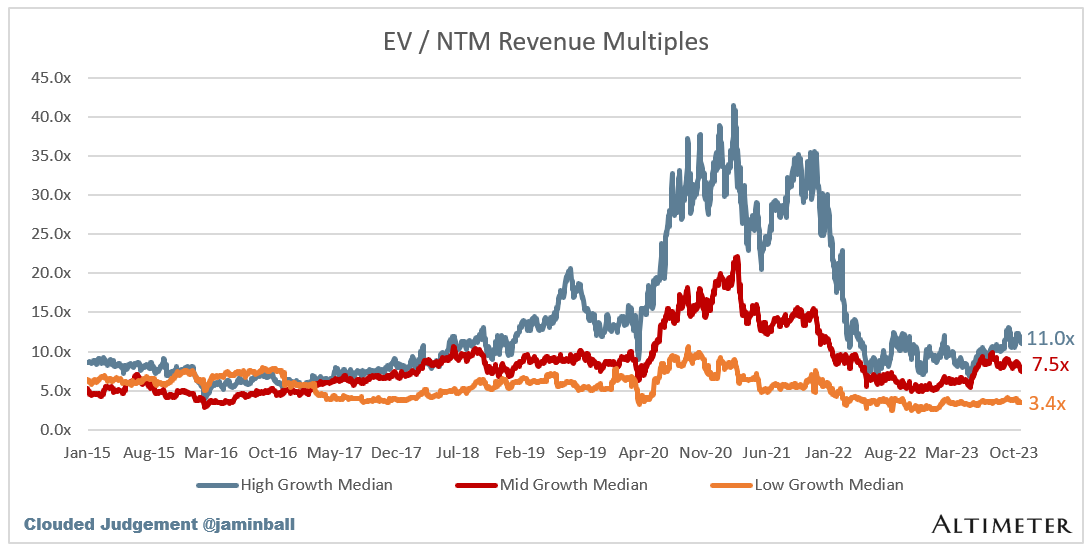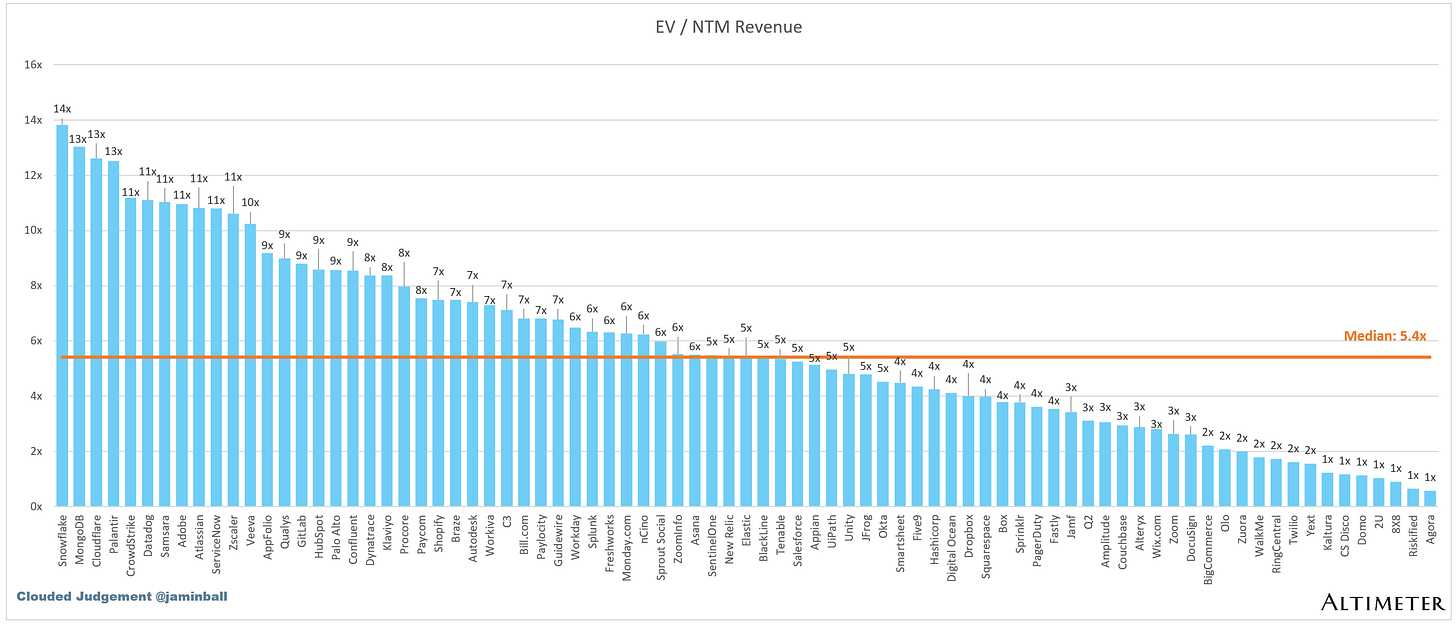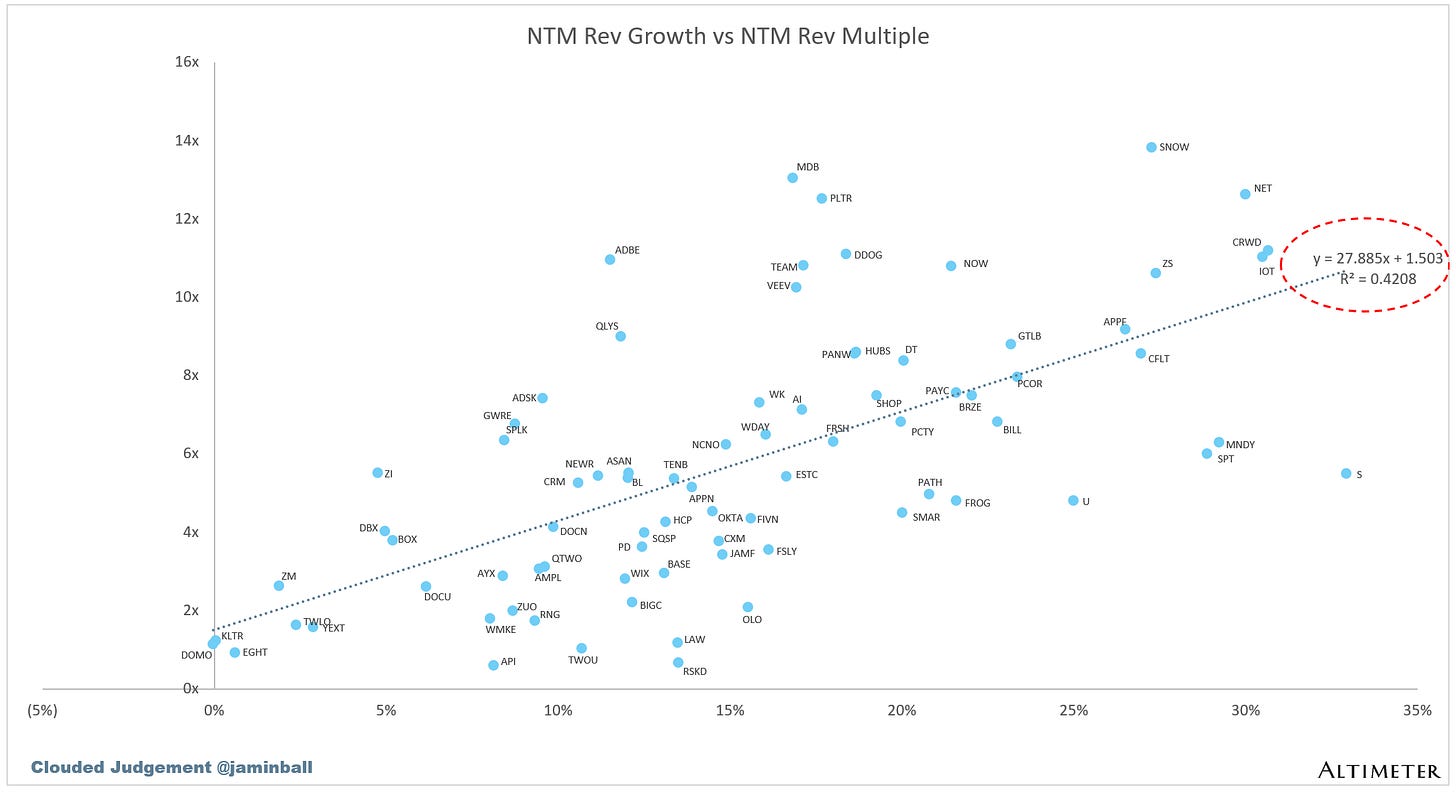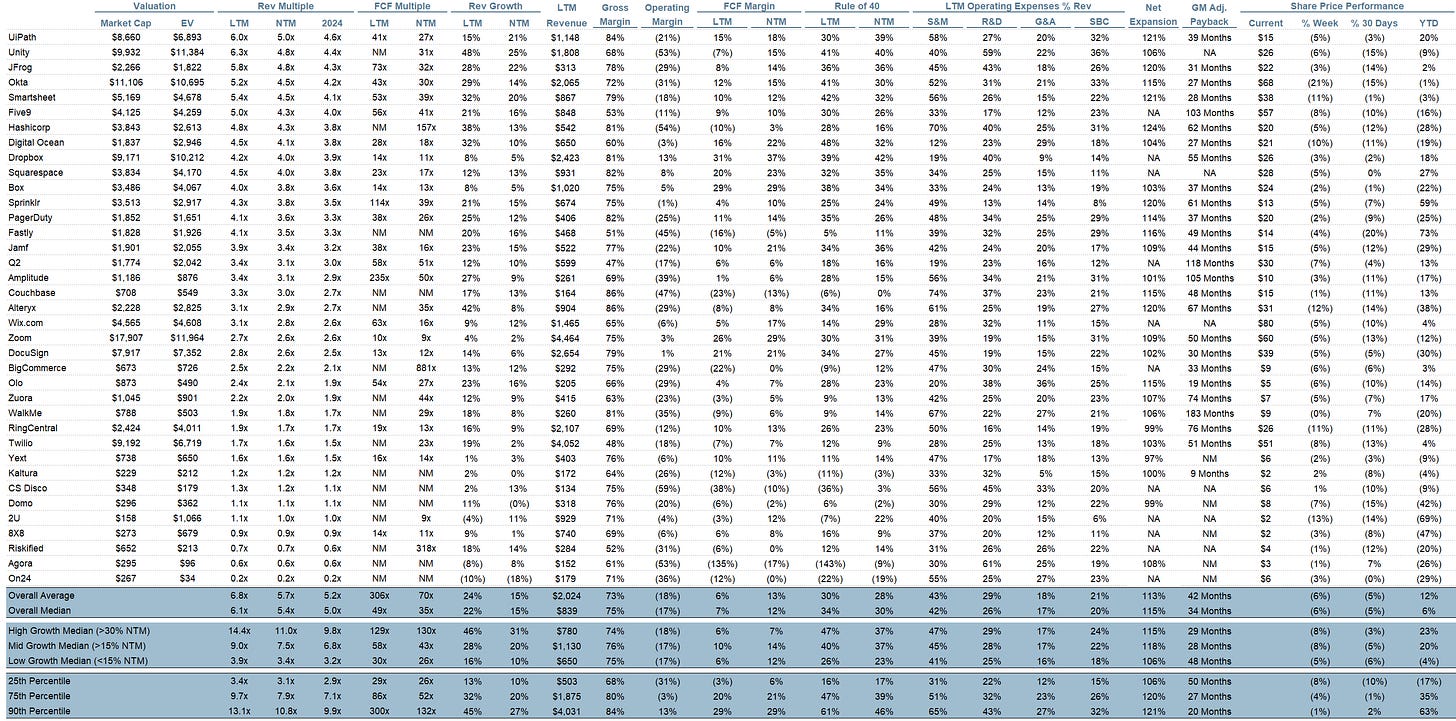Every week I’ll provide updates on the latest trends in cloud software companies. Follow along to stay up to date!
Cloud Giants Report Q3 ‘23
Not a great signal for software this week from the Cloud Giants (AWS, Azure and Google Cloud)…After Q2 (3 months ago), the tone from the Cloud Giants around optimizations was largely: optimizations have started to ease, and net new workloads have picked up. You can see some quotes from Azure / AWS in my Q2 recap, and pasted below.
I believe one of the bigger reasons software has held up despite the run up in the 10Y to 5% is the expectation for re-acceleration (ie numbers / forecasts going up). Either that or folks are expecting the 10Y to fall back to 3.5% which feels unlikely. Software multiples today are at the same place they were (on average) in May when the 10Y was at 3.4%. After the cloud giants reported this week, the timing of the presumed re-acceleration is very much in question. This quarter, the messaging was more of “optimizations are continuing.” (in contrast to the more upbeat messaging 3 months ago). We would have expected to start lapping the start of optimizations (which largely started in Q3 ‘22), and see even more strength of new workloads coming online. But alas, the qualitative commentary didn’t suggest this (which seemed like a slight reversal from the commentary 3 months ago). AWS was the the most positive sounding when it came to trends around optimizations. Let’s look at the quantitative figures.
Here’s a broad update on AWS, Azure and Google Cloud:
AWS (Amazon): $92B run rate growing 12% YoY (last Q grew 12%)
Azure (Microsoft): ~$66B run rate (estimate) growing 28% YoY (last Q grew 27%)
Google Cloud (includes GSuite): $34B run rate growing 22% YoY (last Q grew 28%, neither are cc)
This week gave us a preview for what’s to come with Q3 earnings for the broader software universe. On Tuesday, Azure and Google spooked the market. While Azure came in quite strong (28% YoY growth in constant currency vs 27% last quarter), they made a number of comments suggesting optimization pressure didn’t get any better from last quarter. They didn’t say they got worse, but didn’t say they improved at all. Further they said: “For H2 [H2 for their fiscal year is the quarters ending March ‘24 and June ‘24], assuming the optimization and new workload trends continue and with the growing contribution from AI, we expect Azure revenue growth in constant currency to remain roughly stable compared to Q2.” There were a lot of people calling for cloud re-acceleration next year, and this data point suggest stable growth vs accelerating growth. Of course, this is still months away, and the most likely explanation is Azure just being quite conservative with their commentary on outer quarters.
Azure also benefits significantly from their AI services. They called out 3% of growth this quarter was from Azure AI, which implies Azure AI is at a $1.5B run rate! Last quarter Azure AI was at a $500m run rate. 200% growth QoQ is insanely impressive. Staggering scale already. However - let’s peel off AI from Azure. No one else has this kind of massive benefit, so if we want to look at takeaways from the Azure quarter as it relates to the rest of software, we should look at Azure ex AI. Ex AI, Azure grew ~25% YoY (28% constant currency growth less 3% from AI). Last quarter, Azure ex AI grew 26% YoY (27% constant currency growth with 1% coming from AI). So while everyone was very excited about Azure overall accelerating, unfortunately Azure ex AI decelerated again in Q3. Let’s also look at the guide for next quarter. Azure guided to 26-27% Azure growth, “with increasing contribution from AI.” This quarter AI contributed 3%. If next quarter it’s 4%, then the implied guide for Azure ex AI is more like 22-23%. This would imply a decel of Azure ex AI from 26% last quarter to 25% this quarter to 22-23% next quarter. Azure even gave some light commentary on the first two quarters of 2024 (the quote I pasted above) saying they expect stable growth in those quarters to the quarter ending December ‘23. If we assume AI continues to grow, then overall stable Azure growth implies more decel in Azure ex AI in the first half of next year. Quite different then the expectation for acceleration in software in 2024. That trend is a better indicator for what’s to come from the broader software universe, and why everything sold off on Wednesday.
At the same time - Google Cloud also massively decelerated from 28% last quarter to 22% this quarter. Google Cloud did have a huge Q3 in 2022, so the YoY comp for this quarter was a tough one (ie lots of the decel from 28% to 22% was more mathematical, and not quite as bad as the numbers would suggest). Like Azure, they also gave qualitative feedback that optimizations persist and aren’t getting lighter.
AWS was the most positive sounding when it came to trends around optimizations. They had a similar message to last quarter of optimizations starting to slow down, and new workload strength continuing. You can read some quotes from their earnings call below.
Below are some charts on Azure, AWS and Google Cloud
Azure
AWS
Google Cloud
Here are some quotes from all 3 earnings calls:
Azure:
“In Azure, as expected, the optimization trends were similar to Q4 [Q4 for Microsoft is the quarter ending June 30]”
“Second thing, of course, is the workloads start, then workloads are optimized and then new workloads start. And that cycle continues. We'll lap some of those optimization cycles that were fairly extreme perhaps in the second half of our fiscal.[second half of their fiscal year are the months January - June 2024. This implies the strongest optimizations were in the first half of 2023]”
“For H2, assuming the optimization and new workload trends continue and with the growing contribution from AI, we expect Azure revenue growth in constant currency to remain roughly stable compared to Q2."
“We've been very consistent that the optimization trends have been consistent for us through a couple of quarters now. Customers are going to continue to do that. It's an important part of running workloads. That is not new.”
AWS
“AWS' year-over-year growth rate continued to stabilize in Q3. And while we still saw elevated cost optimization relative to a year ago, it's continued to attenuate as more companies transition to deploying net new workloads.”
“While optimization still remain a headwind, we've seen the rate of new cost optimization slowdown in AWS, and we are encouraged by the strength of our customer pipeline.”
Google Cloud:
“On cloud, maybe what I would say is, overall, we had definitely started seeing customers looking to optimize spend. We leaned into it to help customers given some of the challenges they were facing. And so that was a factor.”
Quarterly Reports Summary
Top 10 EV / NTM Revenue Multiples
Top 10 Weekly Share Price Movement
Update on Multiples
SaaS businesses are generally valued on a multiple of their revenue - in most cases the projected revenue for the next 12 months. Revenue multiples are a shorthand valuation framework. Given most software companies are not profitable, or not generating meaningful FCF, it’s the only metric to compare the entire industry against. Even a DCF is riddled with long term assumptions. The promise of SaaS is that growth in the early years leads to profits in the mature years. Multiples shown below are calculated by taking the Enterprise Value (market cap + debt - cash) / NTM revenue.
Overall Stats:
Overall Median: 5.4x
Top 5 Median: 12.6x
10Y: 4.9%
Bucketed by Growth. In the buckets below I consider high growth >30% projected NTM growth, mid growth 15%-30% and low growth <15%
High Growth Median: 11.0x
Mid Growth Median: 7.5x
Low Growth Median: 3.4x
EV / NTM Rev / NTM Growth
The below chart shows the EV / NTM revenue multiple divided by NTM consensus growth expectations. So a company trading at 20x NTM revenue that is projected to grow 100% would be trading at 0.2x. The goal of this graph is to show how relatively cheap / expensive each stock is relative to their growth expectations
EV / NTM FCF
The line chart shows the median of all companies with a FCF multiple >0x and <100x. I created this subset to show companies where FCF is a relevant valuation metric.
Companies with negative NTM FCF are not listed on the chart
Scatter Plot of EV / NTM Rev Multiple vs NTM Rev Growth
How correlated is growth to valuation multiple?
Operating Metrics
Median NTM growth rate: 15%
Median LTM growth rate: 21%
Median Gross Margin: 75%
Median Operating Margin (18%)
Median FCF Margin: 7%
Median Net Retention: 114%
Median CAC Payback: 35 months
Median S&M % Revenue: 42%
Median R&D % Revenue: 27%
Median G&A % Revenue: 16%
Comps Output
Rule of 40 shows rev growth + FCF margin (both LTM and NTM for growth + margins). FCF calculated as Cash Flow from Operations - Capital Expenditures
GM Adjusted Payback is calculated as: (Previous Q S&M) / (Net New ARR in Q x Gross Margin) x 12 . It shows the number of months it takes for a SaaS business to payback their fully burdened CAC on a gross profit basis. Most public companies don’t report net new ARR, so I’m taking an implied ARR metric (quarterly subscription revenue x 4). Net new ARR is simply the ARR of the current quarter, minus the ARR of the previous quarter. Companies that do not disclose subscription rev have been left out of the analysis and are listed as NA.
Sources used in this post include Bloomberg, Pitchbook and company filings
The information presented in this newsletter is the opinion of the author and does not necessarily reflect the view of any other person or entity, including Altimeter Capital Management, LP ("Altimeter"). The information provided is believed to be from reliable sources but no liability is accepted for any inaccuracies. This is for information purposes and should not be construed as an investment recommendation. Past performance is no guarantee of future performance. Altimeter is an investment adviser registered with the U.S. Securities and Exchange Commission. Registration does not imply a certain level of skill or training.
This post and the information presented are intended for informational purposes only. The views expressed herein are the author’s alone and do not constitute an offer to sell, or a recommendation to purchase, or a solicitation of an offer to buy, any security, nor a recommendation for any investment product or service. While certain information contained herein has been obtained from sources believed to be reliable, neither the author nor any of his employers or their affiliates have independently verified this information, and its accuracy and completeness cannot be guaranteed. Accordingly, no representation or warranty, express or implied, is made as to, and no reliance should be placed on, the fairness, accuracy, timeliness or completeness of this information. The author and all employers and their affiliated persons assume no liability for this information and no obligation to update the information or analysis contained herein in the future.






















It doesn't make sense to track YOY or QoQ revenue growth percentage for companies at this scale. For startups, new IPOs, hypergrowth stage - yes. But the investment "community" stressing and over-reaction to declining percentage growth numbers of large scale companies is silly - they're beyond the hypergrowth stage. It's just math - as the denominator grows, the numerator has to grow more Instead, these reports would be improved by focusing on revenue dollars and dollar growth. Flat or declining absolute growth is a solid concern. Flat percentage growth for a $10 billion operation isn't.
Lots of companies started cloud optimizations projects at the end of 2022 and H1 of 2023. It seems like the effect of these optimizations might have just shown up on the cloud providers' side.
Cost optimization projects can be either "one and done" or "bend the (growth) curve". The former favors the narrative that net new workloads will continue to pick up. The latter suggests existing customer will no longer grow at the same rate.